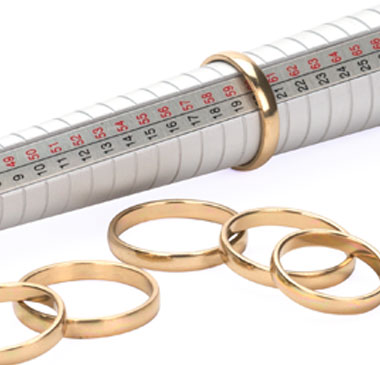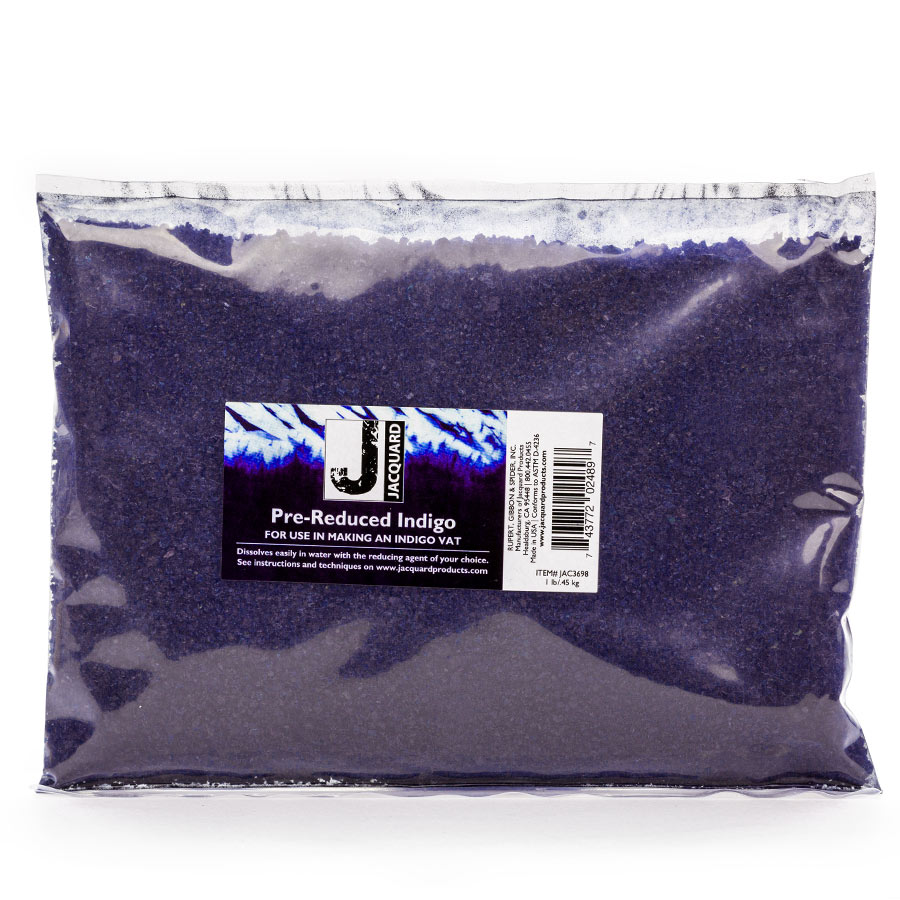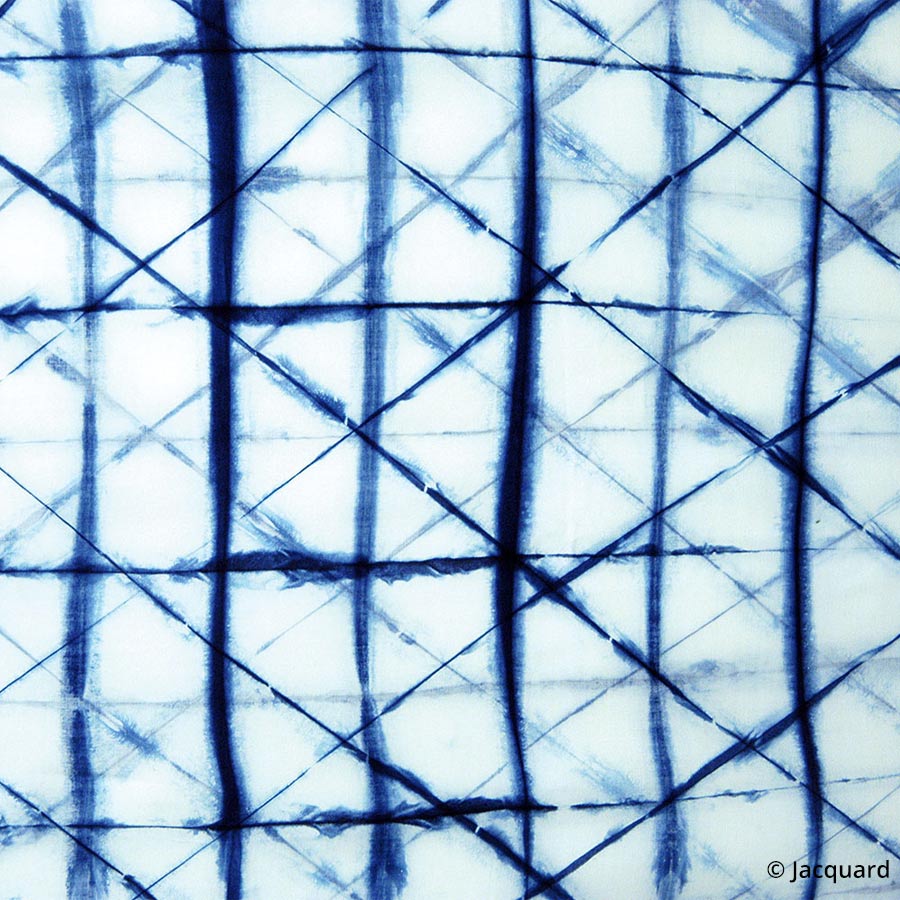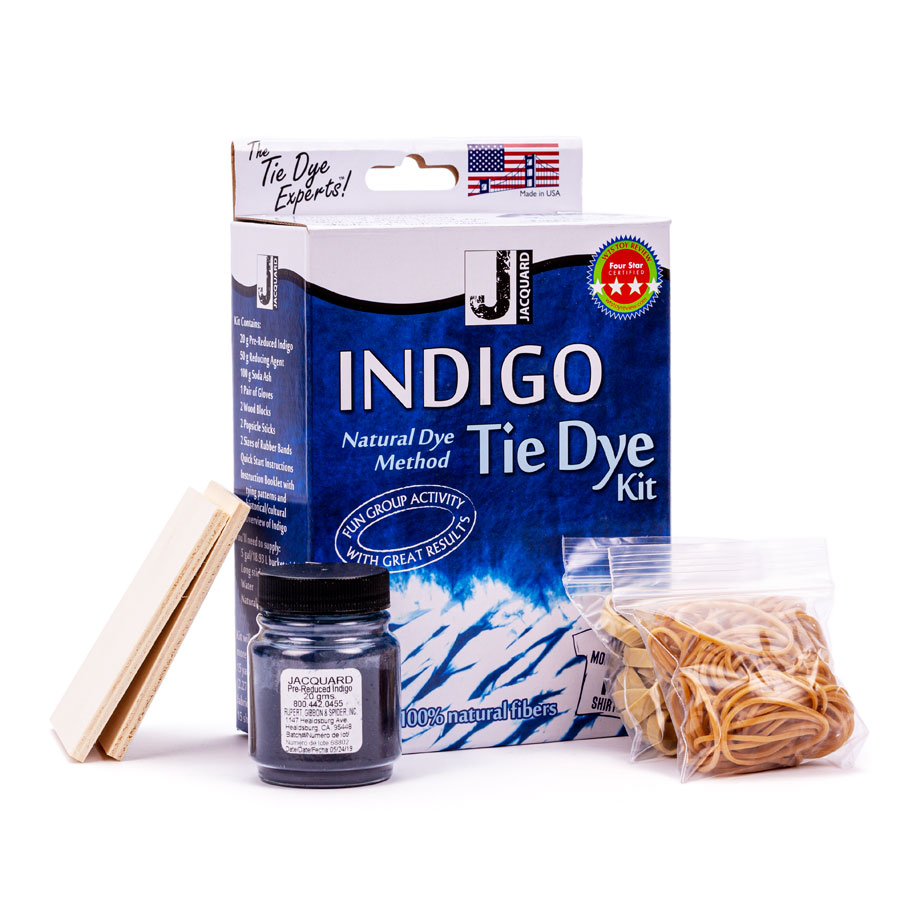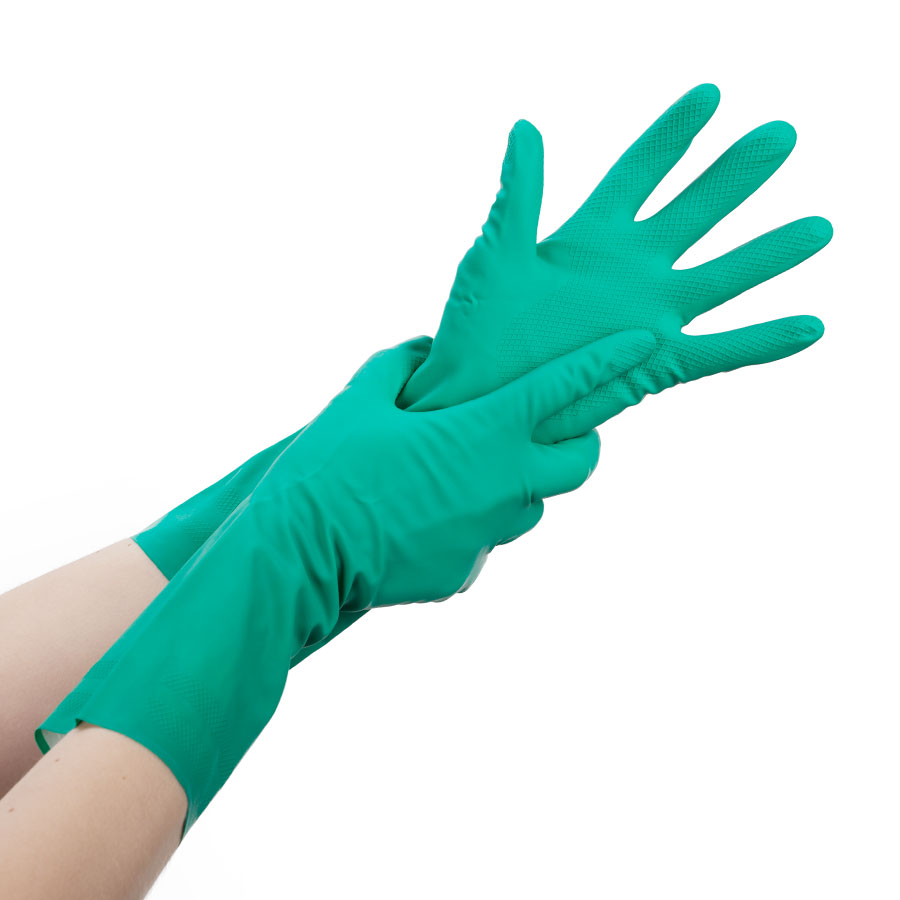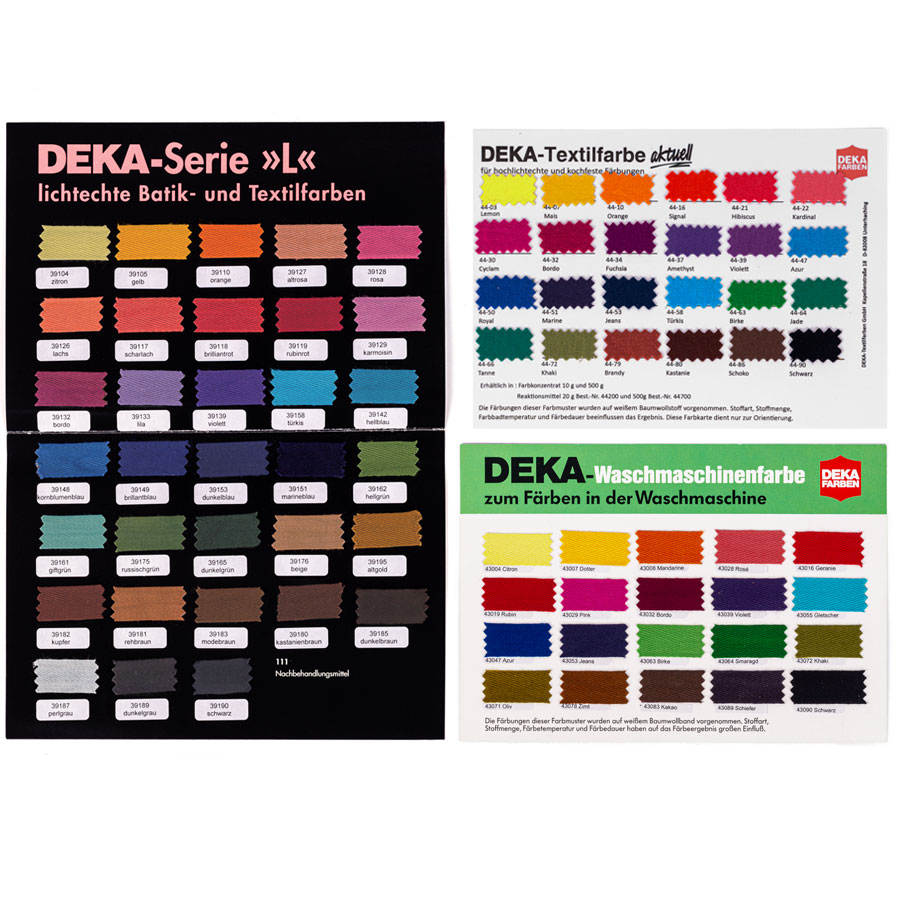Indigo Textile Dye
Available, delivery time: 1-3 days
Turn blue with indigo
With the pre-reduced Indigo by Jacquard you can very easily and quickly dye textiles blue.
Try this magical natural product and see for yourself how the blue colour develops when exposed to air.
You only need a few tools and Indigo powder to create stunning batik works.
What exactly is indigo?
Indigo can be found in plants that grow all over the world. It is virtually the only blue colour that occurs in nature.
With its fascinating history, indigo is just as amazing in its application:
The blue colour appears "magically" when dipped fabrics are exposed to oxygen!
This unique property distinguishes indigo from any other dye and makes it particularly suited for pattern techniques.
Indigo produces a large palette of blue shades, from a light sky blue to the deepest navy blue.
Appreciated by countless cultures for thousands of years, indigo is still used today to dye blue jeans.
Jacquard's synthesized indigo is molecularly identical to the naturally occuring dye and is supplied 60% pre-reduced to ensure unprecedented ease of use.
Fibres that can be dyed
All natural materials such as: cotton, linen, silk, canvas, hemp, wool, wood and more
How do I dye with indigo?
Preparation:
This special indigo formulation is already 60% reduced, so that you can use soda instead of lye in the dye vat.
You need:
• 20g pre-reduced indigo (water soluble)
• 100g sodium carbonate (soda)
• 50g reducing agent sodium hydrosulfite (e.g. Jacquard Sodium Hydrosulfite)
• a 20 - 30 L bucket with lid (e.g. a hobbock bucket - these are very low-priced and high)
• a long stick for stirring
• 15 L of warm water
• natural fabrics (up to 2.5 kg of fabric or 15 t-shirts)
• possibly a plastic sheet on which you place the bucket (to protect the ground)
The pre-reduced indigo dye is extremely easy to use and makes the setting up of an indigo vat almost effortless. It is not necessary to mix the indigo granules as they dissolve easily in water.
Setting up the indigo vat:
1. Fill a 20 L bucket with 15 L of warm tap water (take a high bucket with small diameter).
2. Pour the content of the pre-reduced indigo dye pack into the water. Stir well.
3. While you stir, add slowly the Soda (sodium carbonate) and the reducing agent (sodium dithionite) to the water.
4. Stir the vat carefully but thoroughly in one direction in circles. As soon as all is well mixed, proceed more slowly, stirring in the other direction. Pull the stick along the outer edge of the vat before removing it. Cover the vat with a lid and leave for at least 15 - 30 minutes. For best results wait for an hour.
5. Once the content of the vat has settled, remove the lid. The top of the dye bath may now be covered with a thin blue skin (rather than the traditional 'foam flower').
Wearing gloves, move the skin (or foam flower) carefully to the side. The dye bath should have a clear yellow or yellow-greenish colour under the flower. If not, wait for another half hour and check again.
The dye bath lasts for several weeks.
Dyeing indigo:
1. Fold, bind or tie your garment or the fabric (see "pattern ideas" on pages 7-11 of the included instructions)
2. Humidify the fabric thoroughly or soak it in water.
3. When you begin dyeing, remove the lid from the bucket. If a thin blue skin is swimming on the surface, push it gently to the side (make sure to wear gloves).
4. Press excess water and air out of the fabric.
5. While still pressing the fabric, dip the textile slowly into the dye vat. Then move the textile carefully to make sure the colour penetrates evenly the parts you have not tied. Move the piece in the vat under the water surface for several minutes. Do not let the fabric fall into the vat or sink to the bottom. As residues will have settled on the bottom, you should not stir these while dyeing. They may stain your dyed piece.
6. When you're ready to take the fabric out of the vat, squeeze it slightly just under the surface while removing it slowly from the vat. Avoid splashes on the water surface as this will return oxygen to the vat. The fabric will be yellow-green like the content of the container. The fabric will turn blue very slowly as soon as the oxygen in the air comes in contact with it. Place the lid back on the container.
7. Put the fabric to the side so that the piece can oxidize completely. Turn the piece frequently to get oxygen everywhere and let oxidize for 20 minutes.
8. When the colour is oxidized you can either repeat steps 4 - 7 to achieve darker blue tones (when wet the colour looks much darker. Once dry a dark blue turns middle blue most of the time). Or remove the excess indigo from the piece through washing with a mild detergent and warm water.
9. As soon as you're done with dyeing, stir gently in circles with the stir stick in the bucket as previously. Place lid back on the vat and leave for at least an hour before using the dye bath again. The dye bath will last several days and you can dye repeatedly.
10. When the dye is exhausted or if you no longer wish to dye, pour the content into the drain. You can clean bucket and utensils with a cleaning agent (e.g. scouring powder) or soap.
If you wish to stock the dye bath: stock the dye in the vat (closed with the lid) in a place with a room temperature of 20-29°C. Keep out of the reach of children and animals.
Care of the indigo container:
An indigo dye container can have a very long life if used and maintained regularly. The best dye container has a cylindrical shape and tightly closing lid (e.g. a hobock bucket). That gives you enough space to dye the fabric without it touching the bottom and minimizes the surface in contact with air.
Occasionally it may be necessary to add more of the reducing chemicals and of the pre-reduced indigo dye to keep the vat operation going.
Always try to dissolve the sodium carbonate (soda) in a little water before you put it in the vat. Always add little quantities. Better repeatedly than too much the first time.
If you add something to the vat it is important to wait for the chemical reaction (at least for an hour) before you add more.
• If the vat looks rather blue-green than yellow-green or if you see blue particles floating in the liquid, the vat must be reduced more. Add 2 to 10 grams of reducing agent (sodium hydrosulfite) at a time.
• If the colour appears weak or if the liquid in the vat is grey and watery, an addition of the pre-reduced indigo dye is necessary. Add 2 to 10 gram at a time.
Content: 21g / 230g / 450g
Selling unit: 1 piece (21g / 230g / 450g)
Dye indigo:
In addition to the Indigo Tie Dye Kit you need:
• a 20 L bucket with lid (e.g. a hobbock bucket - they're very low-priced and high enough )
• a long stick for stirring
• water
• natural fabrics (up to 2,5 kg of fabric or 15 t-shirts)
• possibly a plastic sheet on which you place the bucket (to protect the ground)
Setting up the indigo vat:
1. Fill a 20 L bucket with 15 L of warm tap water (take a high bucket with small diameter).
2. Pour the content of the pre-reduced indigo dye pack into the water. Stir well.
3. While you stir, add slowly the soda ash and the reducing agent (sodium hydrosulfite - Jacquard Sodium Hydrosulfite) to the water.
4. Stir the vat carefully but thoroughly in one direction in circles. As soon as all is well mixed, proceed more slowly, stirring in the other direction. Pull the stick along the outer edge of the vat before removing it. Cover the vat with a lid and leave for at least 15 - 30 minutes. For best results wait for an hour.
5. Once the content of the vat has settled, remove the lid. The top of the dye bath may now be covered with a thin blue skin (rather than the traditional 'foam flower').
Wearing gloves, move the skin (or foam flower) carefully to the side. The dye bath should have a clear yellow or yellow-greenish colour under the flower. If not, wait for another half hour and check again.
The dye bath lasts for several weeks.
Dyeing of indigo:
1. Fold, bind or tie your garment or the fabric (see "pattern ideas" on pages 7-11 of the included instructions)
2. Humidify the fabric thoroughly or soak it in water.
3. When you begin dyeing, remove the lid from the bucket. If a thin blue skin is swimming on the surface, push it gently to the side (make sure to wear gloves).
4. Press excess water and air out of the fabric.
5. While still pressing the fabric, dip the textile slowly into the dye vat. Then move the textile carefully to make sure the colour penetrates evenly the parts you have not tied. Move the piece in the vat under the water surface for several minutes. Do not let the fabric fall into the vat or sink to the bottom. As residues will have settled on the bottom, you should not stir these while dyeing. They may stain your dyed piece.
6. When you're ready to take the fabric out of the vat, squeeze it slightly just under the surface while removing it slowly from the vat. Avoid splashes on the water surface as this will return oxygen to the vat. The fabric will be yellow-green like the content of the container. The fabric will turn blue very slowly as soon as the oxygen in the air comes in contact with it. Place the lid back on the container.
7. Put the fabric to the side so that the piece can oxidize completely. Turn the piece frequently to get oxygen everywhere and let oxidize for 20 minutes.
8. When the colour is oxidized you can either repeat steps 4 - 7 to achieve darker blue tones (when wet the colour looks much darker. Once dry a dark blue turns middle blue most of the time). Or remove the excess indigo from the piece through washing with a mild detergent and warm water.
9. As soon as you're done with dyeing, stir gently in circles with the stir stick in the bucket as previously. Place lid back on the vat and leave for at least an hour before using the dye bath again. The dye bath will last several days and you can dye repeatedly.
10. When the dye is exhausted or if you no longer wish to dye, pour the content into the drain. You can clean bucket and utensils with a cleaning agent (e.g. scouring powder) or soap.
If you wish to stock the dye bath: stock the dye in the vat (closed with the lid) in a place with a room temperature of 20-29°C. Keep out of the reach of children and animals.
2 of 2 reviews
5 out of 5 stars
Login
July 21, 2022 05:39
Super schnell und tolle Produkte
Ich habe Indigofarbe und das dazugehörige Reduziermittel bestellt. Die Lieferung kam sehr schnell und nach einem ersten Testfärben, bin ich von dem Produkt begeistert. Intensive blaue Farbe und nach dem Rezept von Patina auch sehr leicht zu verarbeiten. Ich habe schon verschiedene Indigofarbstoffe ausprobiert, pflanzlich oder synthetisch, und bin von der der vorreduzierten Variante von Patina begeistert, da sie einfacher in der Anwendung ist und die Farbe sehr gleichmäßig und kräftig ist.
October 28, 2020 14:46
Worked perfectly
Used this as part of a craft project to try making my own jeans. I've tried a few different fabric dyes in the past, and I really liked this one - the instructions were simple and it was easy to control the strength of the colour. Definitely planning to buy again!
Accessories
Content: 0.45 Kilogram (€42.11* / 1 Kilogram)
Content: 0.8 Kilogram (€32.44* / 1 Kilogram)
Similar Products
Content: 10 Gram (€0.30* / 1 Gram)
Content: 10 Gram (€0.32* / 1 Gram)
Content: 14 Gram (€0.46* / 1 Gram)
Content: 22 Gram (€0.84* / 1 Gram)
Content: 0.2 Kilogram (€59.75* / 1 Kilogram)
Customer Also Viewed
Content: 0.227 Kilogram (€250.88* / 1 Kilogram)
Content: 4 Piece (€3.24* / 1 Piece)
Customer Also Bought
Content: 0.014 Kilogram (€389.29* / 1 Kilogram)
Content: 14 Gram (€0.50* / 1 Gram)
Content: 0.5 Kilogram (€3.70* / 1 Kilogram)
Content: 0.014 Kilogram (€389.29* / 1 Kilogram)
Content: 14 Gram (€0.50* / 1 Gram)
Content: 0.5 Kilogram (€129.90* / 1 Kilogram)
Content: 10 Gram (€0.32* / 1 Gram)
Content: 0.5 Kilogram (€149.90* / 1 Kilogram)
 We ship worldwide
We ship worldwide Top customer satisfaction!
Top customer satisfaction! Many payment options
Many payment options






